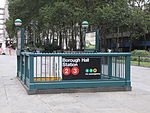Henry Ward Beecher Monument
1890 sculptures1891 establishments in New York (state)Bronze sculptures in BrooklynDowntown BrooklynGranite sculptures in New York City ... and 7 more
Monuments and memorials in BrooklynOutdoor sculptures in BrooklynSculptures by John Quincy Adams WardSculptures of children in the United StatesSculptures of men in New York CitySculptures of women in New York CityStatues in New York City

The Henry Ward Beecher Monument, a statue of Henry Ward Beecher created by the sculptor John Quincy Adams Ward, was unveiled on June 24, 1891 in Borough Hall Park, Brooklyn and was later relocated to Cadman Plaza, Brooklyn in 1959.
Excerpt from the Wikipedia article Henry Ward Beecher Monument (License: CC BY-SA 3.0, Authors, Images).Henry Ward Beecher Monument
Johnson Street, New York Brooklyn
Geographical coordinates (GPS) Address External links Nearby Places Show on map
Geographical coordinates (GPS)
| Latitude | Longitude |
|---|---|
| N 40.694861111111 ° | E -73.990111111111 ° |
Address
Henry Ward Beecher Monument
Johnson Street
11201 New York, Brooklyn
New York, United States
Open on Google Maps











